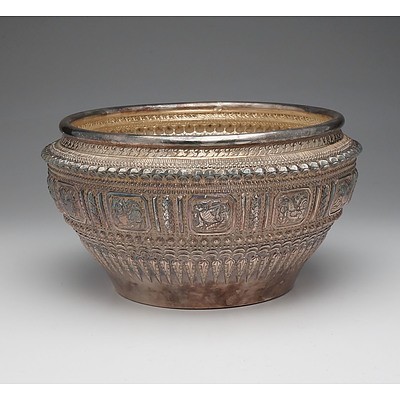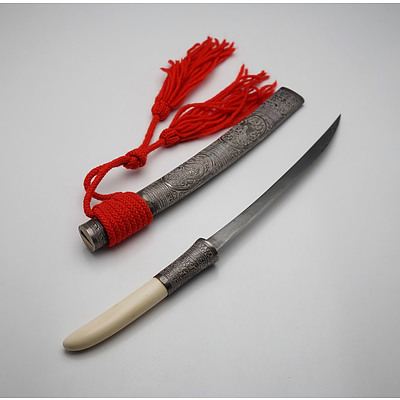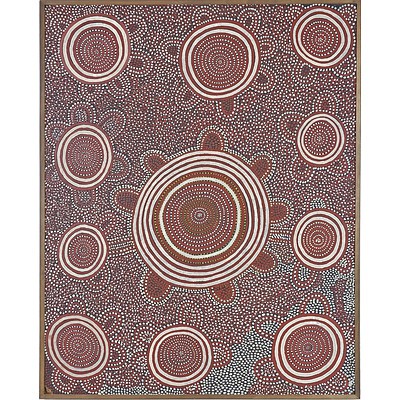Antiquities from the Estate of the Renowned Canberra Figure
Learn about events, happenings and more
The Storied Estate of the Late Barrie Dexter
Wednesday, 20 July 2022 | Mackenzie Haskins

Barrie Dexter is remembered as both a pioneer in indigenous affairs and as an influential diplomat. At the ‘Department of External Affairs’ as a senior diplomat, Dexter was instrumental in establishing many of the positive foreign relationships that still exist today. His progressive views, which were reflected in his policy, introduced improvements in modern Indigenous Australian affairs. Dexter is remembered for his years of service in the Department of Aboriginal Affairs where he spent the most part of his career. Over Dexter’s notable career he was gifted various antiques treasured by his family as mementos of his career. ALLBIDS had the privilege to recently auction a selection of these items on behalf of the family.
Dexter was born in Kilsyth, Victoria in 1921 as one of six children. During adolescence he was awarded a scholarship to attend the prestigious Geelong Grammar School. From there he attended Melbourne University before enlisting in the Australian Imperial Force in 1941. Dexter saw active service in New Guinea in a specialised commando unit. He also served in Nagasaki, as a part of the occupying forces shortly after the city was bombed.
In 1948 Dexter was selected by the Department of External Affairs for a cadetship in Canberra. This is where he met his wife Judith Craig and the couple married in 1950. Barrie and Judith went on to have three children.
Dexter’s proficiency in languages such as French, German & Latin, assured his position on various postings. His first posting was in London and shortly thereafter to Lebanon, to train in Arabic. Whilst posted in Egypt he and Judith welcomed their first daughter. Dexter was posted to Washington during the Cuban Missile Crisis before also serving as a diplomat in Ghana, Laos, Yugoslavia and Canada.
Whilst in Laos, Dexter impassioned many young Hmong to come and study in Australia under the Colombo plan. The program was introduced to strengthen relationships within Asia and the Pacific, scholarships for students was central to this. Many students lived with Dexter and his wife after the couple had returned to Canberra.

This piece is one of the many antiques gifted to Dexter over his esteemed career. This Lao Silver Repousee Bowl, decorated with the Twelve Zodiac Animals was likely a gift given to him in Laos or from a student in Australia. Until the revolution in 1975 The Kingdom of Laos was busy thoroughfare between China, Cambodia, Burma and Thailand. This art shows influence from all four regions and its materials were likely sourced from as far as France. This antique sold on auction for $4,110 AUD.

This Lao Ivory Handled Ceremonial Sword was gifted to Barrie Dexter by the Prime Minister of Laos Souvanna Phouma. Dexter was the Australian Ambassador to Laos for years. Prince Phouma and Dexter’s relationship would have been supported by their shared progressive views. The blade was given in a decorative silver sheath and a plaque dedicating the gift from Prince Phouma. This antique sold at auction for $750 AUD.
During his postings, Dexter’s passion for indigenous and ethnic minorities resulted in his appointment to the Commonwealth Council for Aboriginal Affairs. Prime Minister Harold Holt formed the council, plotting Dexter with economist H.C. Coombs and anthropologist William Stanner. The council was established to advise on national policy regarding landownership, Aboriginal development and identity politics. Dexter noted that after Holt’s disappearance in 1967 many of the advantages the council had hoped for didn’t come to fruition. The subsequent two prime ministers; John Gorton and William McMahon had little interest in supporting the council.
Dexter maintained his position through successive political regimes including the Whitlam government. Whitlam supported many of the original policies slated by Dexter, Stanner and Coombs such as land rights, the movement to outstations, social welfare and community-based economies. The council was instrumental for over a decade in influencing federal Aboriginal Affairs. Dexter’s council established the Land Title policy for Australia. This policy introduced packages of generational reform for indigenous people and today acts as a foundation for reform policies to this day.

John Kipara Tjakamarra (Pintupi 1931-2003) Tingari Dreaming at Warupuyunya Circa 1971-2
Dreaming at Warupuyunya by John Kipara Tjakmarra (circa 1971-2) is a painting originating from the group of important modern aboriginal artists from the small community, Papunya. The desert painting movement began in 1971 in the small town nearby Alice Springs and John Kipara Tjakmarra was a renowned member of this cohort. It is unknown when Dexter came into possession of this piece but it likely is in commemoration for his work at The Commonwealth Council for Aboriginal Affairs. Dexter’s ownership of this painting reflects his understanding of Indigenous affairs and there’s no doubt he would have understood the significance of the desert painting movement. This artwork sold at auction for $9,010 AUD.
ALLBIDS was honoured to host this antique online auction for such an influential Canberra figure. Learning the significance tale of each item gave phenomenal insight into how highly regarded he was both in Australia and abroad. His legacy lives on through his three children and the progressive policies he introduced, echoes of which are still witnessed today.
Here at ALLBIDS, we can assist with downsizing or the sale of an estate. For more information follow the link below: https://www.allbids.com.au/t/local-estate
